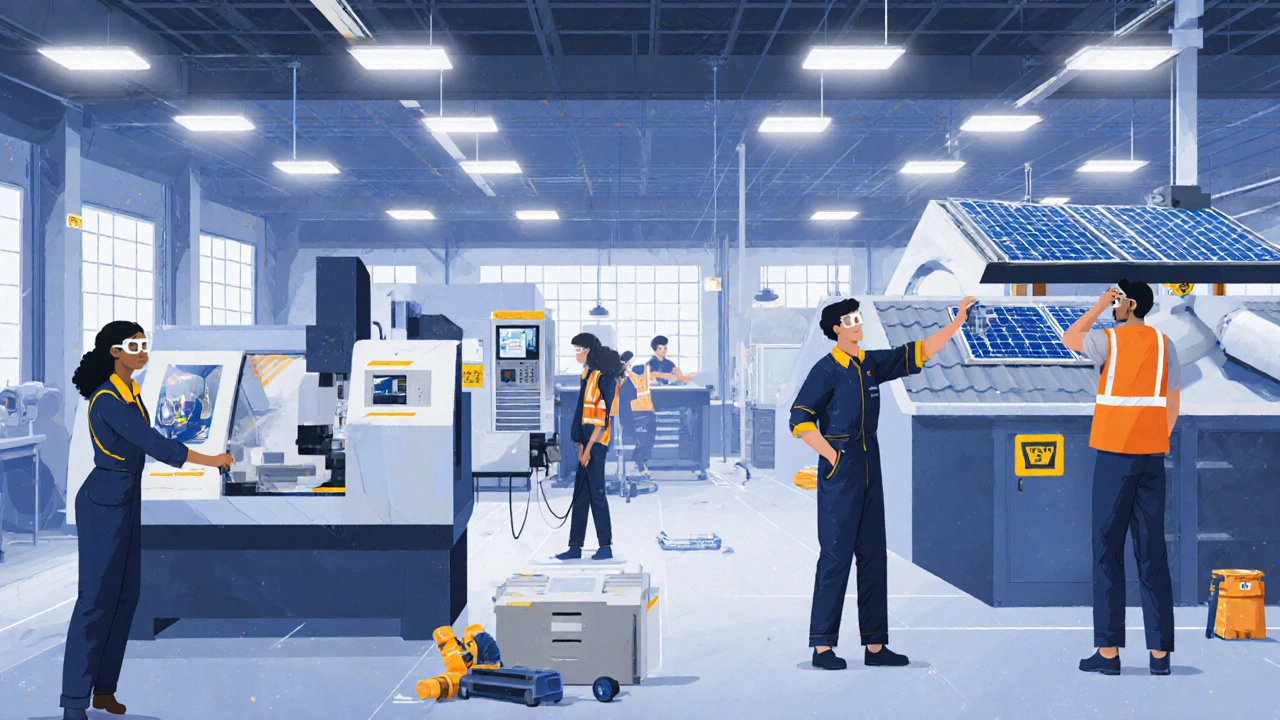
Vocational Degree Pathway Planner
Recommended Vocational Pathways
Vocational degrees focus on practical skills for specific careers and typically take 1-2 years to complete. They offer faster entry into the workforce compared to traditional academic degrees, with lower costs and strong industry connections.
- Associate degrees: 2-year programs combining general education with trade-specific courses
- Certificates: Short-term credentials (6-12 months) validating specific skill sets
- Diplomas: Practical training programs ranging from 12 months to 2 years
- Apprenticeships: Work-based learning where you earn while you learn
When you hear the term vocational degree is a post‑secondary credential that focuses on practical skills for specific trades or occupations, you might wonder how it differs from a traditional university degree. In short, a vocational degree is designed to get you job‑ready fast, often blending classroom learning with hands‑on experience. Below we break down what it really means, the main types, the advantages, and how you can start on the right path.
Defining the Core Concept
A vocational degree sits somewhere between a high‑school certificate and a full‑blown bachelor’s program. It usually takes one to two years to complete and awards qualifications such as an associate degree, a diploma, or a specialized certificate. The curriculum is built around industry standards, meaning you learn the exact tools and techniques employers demand.
Key Types of Vocational Credentials
- Associate degree is a two‑year program that blends general education with focused trade courses, often earned at community colleges.
- Certificate is a short‑term credential, typically 6‑12 months, that validates mastery of a specific skill set.
- Diploma is a program that can range from 12 months to two years, focusing heavily on practical training.
- Apprenticeship is a work‑based learning model where you earn while you learn under a certified mentor.
- Trade school program is an intensive course offered by vocational institutes that prepares students for specific trades like plumbing or electrical work.
How a Vocational Degree Differs from an Academic Degree
| Aspect | Vocational Degree | Academic Degree |
|---|---|---|
| Typical Duration | 1‑2 years | 3‑4 years (bachelor) or more |
| Primary Focus | Hands‑on skills for a specific occupation | Theoretical knowledge and broad liberal arts |
| Entry Requirements | High school diploma or GED; sometimes work experience | High school diploma; often SAT/ACT scores for universities |
| Cost (Average USD) | $3,000‑$15,000 | $30,000‑$100,000+ |
| Typical Starting Salary | $30k‑$55k | $45k‑$70k (varies by field) |
| Path to Advanced Study | Credits can often transfer to associate‑to‑bachelor programs | Direct route to graduate studies (master’s, PhD) |
The table highlights why many people choose a vocational route: faster entry into the workforce, lower tuition, and skills that match current employer needs.
Benefits of Pursuing a Vocational Degree
- Quick Employment: Programs are tailored to high‑demand jobs, so graduates often find work within weeks of graduation.
- Lower Student Debt: Tuition is typically a fraction of university costs, reducing long‑term financial burden.
- Industry Connections: Many schools partner with local businesses for internships, apprenticeships, and job placement.
- Hands‑On Experience: Lab work, simulated environments, and real‑world projects build confidence before you even step on the job.
- Flexibility: Many institutions offer evening, weekend, or online modules, allowing you to study while working.
Top Industries Where Vocational Degrees Shine
While the term "vocational" often conjures up trades like carpentry or plumbing, the scope is far broader today. Here are seven sectors that actively recruit graduates with a vocational credential:
- Healthcare support - roles such as medical assistants, phlebotomists, and radiology technicians.
- Information technology - network technicians, cybersecurity analysts, and cloud support specialists.
- Advanced manufacturing - CNC machinists, robotics technicians, and quality‑control inspectors.
- Construction trades - electricians, plumbers, HVAC installers, and carpenters.
- Hospitality & tourism - culinary arts, hotel management, and event coordination.
- Automotive services - automotive service technicians, diesel mechanics, and auto body repair.
- Renewable energy - solar panel installers, wind turbine technicians, and energy efficiency auditors.

How to Choose the Right Vocational Path
Picking a program isn’t a one‑size‑fits‑all decision. Follow these steps to ensure you land on a credential that aligns with your goals:
- Identify Your Interests: Write down tasks you enjoy-whether it’s fixing things, helping people, or working with computers.
- Research Local Labor Markets: Use government job‑growth statistics (e.g., the U.S. Bureau of Labor Statistics) to spot occupations with strong demand in your region.
- Check Accreditation: Look for programs accredited by bodies like the Council on Occupational Education (COE) or relevant industry unions.
- Assess Costs and Financial Aid: Many community colleges offer federal Pell Grants, state scholarships, or employer‑sponsored tuition assistance.
- Visit Campuses or Virtual Tours: Seeing labs, workshops, and student projects helps gauge the quality of hands‑on training.
- Talk to Alumni: Ask recent graduates where they are employed and whether the program met their expectations.
From Classroom to Career: Typical Journey
Here’s a realistic timeline for someone starting a vocational degree in 2025:
- Month 0‑1: Application, acceptance, and financial aid paperwork.
- Month 2‑4: Core foundational courses (math, communication, basic science).
- Month 5‑10: Technical modules-lab work, simulations, or field placements specific to the chosen trade.
- Month 11‑12: Capstone project or apprenticeship final assessment.
- Month 13: Graduation, résumé building, and job‑search support from the school's career services.
In many cases, the final apprenticeship or internship provides a direct hiring pipeline, so you walk out with a job offer in hand.
Common Misconceptions About Vocational Degrees
Let’s bust a few myths that might be holding you back:
- Myth: Vocational training is only for people who can’t handle academic study.
Fact: It’s a strategic choice for anyone who wants a clear, skill‑focused pathway. - Myth: You can’t advance beyond a vocational credential.
Fact: Many schools allow credit transfer to bachelor's programs, and employers often fund further education. - Myth: Salary potential is low.
Fact: Skilled trades and tech‑focused vocational roles frequently earn six‑figure salaries after a few years of experience. - Myth: Vocational schools lack credibility.
Fact: Accredited institutions meet rigorous standards; industry certifications (e.g., CompTIA, HVAC Excellence) boost employability.
Future Outlook: Why 2025 Is a Prime Year for Vocational Learning
Automation and digital transformation are reshaping the job market. According to a 2024 OECD report, occupations that blend technical know‑how with problem‑solving are projected to grow by 12% over the next decade. Vocational programs are rapidly updating curricula to include robotics, renewable‑energy systems, and cybersecurity fundamentals-areas poised for robust hiring.
Frequently Asked Questions
Is a vocational degree the same as a certificate?
Not exactly. A certificate usually focuses on a single skill set and can be earned in less than a year. A vocational degree, such as an associate degree or diploma, combines multiple courses and often includes general education components, taking up to two years.
Can I transfer credits from a vocational program to a university?
Yes, many community colleges have articulation agreements with four‑year universities. Credits earned in an associate degree often satisfy the first two years of a bachelor’s program, especially in fields like engineering technology or health sciences.
What financing options are available for vocational students?
Students can apply for federal Pell Grants, state scholarships, and workforce development grants. Many employers also sponsor tuition through apprenticeship agreements or tuition‑reimbursement programs.
How does an apprenticeship differ from a traditional classroom program?
Apprenticeships blend paid on‑the‑job training with classroom instruction. You earn a wage while you learn, and the program usually culminates in a nationally recognized certification. Traditional classroom programs may offer internships but generally do not guarantee a salary during study.
Which industries are hiring the most vocational graduates right now?
Healthcare support, information technology, advanced manufacturing, construction trades, renewable energy, and automotive services are all experiencing high demand for skilled vocational graduates in 2025.
Next Steps: Turning Knowledge Into Action
Ready to take the plunge? Here’s a quick checklist to move from curiosity to enrollment:
- Choose a target occupation based on interest and local job data.
- Identify accredited schools offering the relevant vocational credential.
- Complete the application and submit any required transcripts.
- Apply for financial aid early-fill out the FAFSA (or your country’s equivalent) as soon as it opens.
- Schedule a campus visit or virtual demo to see labs and meet instructors.
- Enroll, attend orientation, and start building your skill portfolio right away.
By following these steps, you’ll be on a fast‑track route to a rewarding career that pays well and offers long‑term stability. The world needs skilled hands and minds-your vocational degree can be the bridge between where you are today and where you want to be tomorrow.
